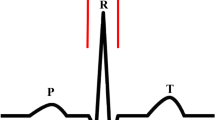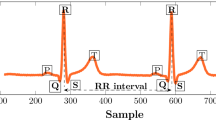Abstract
Accurate QRS detection is crucial for reliable ECG signal analysis and the development of automatic diagnosis tools. In this paper, we propose a simple yet efficient new algorithm for QRS detection using the Stationary Wavelet Transform (SWT). The wavelet transform has been extensively exploited for QRS detection and proved to be an efficient mathematical tool for scale analysis; it provides good frequency components estimation for the input signal and has good localization capability. The proposed procedure exploits solely the first level approximation coefficients of the wavelet transform applied to the bandpass-filtered ECG signal. Therefore, it resulted in a reduced complexity algorithm compared to the existing methods which use many decomposition levels. Thresholding has been implemented using the Pan-Tompkins procedure which is known to be very powerful. Our approach has been assessed over the MIT/BIH benchmark database, the MIT noise stress test database for noise robustness evaluation and the European ST-T database. The obtained results show competitive performance with state-of-the-art algorithms. The proposed scheme achieved a sensitivity of 99.83%, a positive predictivity of 99.94% and a detection error rate of 0.228% using Lead I MIT-BIH Database, this performance is one of the best results over this benchmark, and 99.35% of sensitivity, 99.76% of positive predictivity and detection error rate of 0.9% using the European ST-T Database, hence, our algorithm achieved high performance on Holter environment. Using the MIT noise stress test database, our algorithm achieved 98.77% of sensitivity, 91.01% of positive predictivity, and 10.12% of DER. Thus, our algorithm is robust and outperforms state-of-the-art algorithms on noisy recordings.








Similar content being viewed by others
References
Arzeno NM, Deng Z-D, Poon C-S (2008) Analysis of first-derivative based QRS detection algorithms. IEEE Trans Biomed Eng 55(2):478–484
Belkadi MA, Daamouche A (2017) A new method for accurate QRS detection using stationary wavelet transform. ICCE-B 2017. In: Proceedings of the IEEE 2017 5th international conference on electrical engineering
Belkadi MA, Daamouche A (2020) Swarm intelligence approach to QRS detection. IAJIT 17:4
Benmalek M, Charef A (2009) Digital fractional order operators for r-wave detection in electrocardiogram signal. IET Signal Process 3(5):381–391
Bouaziz F, Boutana D, Benidir M (2014) Multiresolution wavelet-based QRS complex detection algorithm suited to several abnormal morphologies. IET Signal Process 8(7):774–782
Choi S, Adnane M, Lee G-J, Jang H, Jiang ZW, Park H-K (2010) Development of ECG beat segmentation method by combining lowpass filter and irregular R-R interval checkup strategy. Expert Syst Appl 37(7):5208–5218
Chouakri SA, Bereksi-Reguig F (2011) QRS complex detection based on multi wavelet packet decomposition. Appl Math Comput 217(23):9508–9525
Christov II (2004) Real-time electrocardiogram QRS detection using combined adaptative threshold. Biomed Eng Online 3:28
Elgendi M (2013) Fast QRS detection with an optimized knowledge-based method: evaluation on 11 standard ECG databases. PLoS One 8:9
Gutiérrez-Rivas R, García J J, Marnane WP, Hernández Á (2015) Novel real-time low-complexity qrs complex detector based on adaptative thresholding. IEEE Sens J 15(10):6036–6043
Hamilton PS, Tompkins WJ (1986) Quantitative investigation of QRS detection rules using the MIT/BIH arrhythmia database. IEEE Trans Biomed Eng BME 33(2):1157–1165
Kadambe S, Murray R, Boudreaux-Bartels GF (1999) Wavelet transform-based QRS detector. IEEE Trans Biomed Eng 46(7):838–848
Kıymık MK, Güler Ï, Dizibüyük A, Akın M (2005) Comparison of STFT and wavelet transform methods in determining epileptic seizure activity in EEG signals for real-time application. Comput Biol Med 35(7):603–616
Li C, Zheng C, Tai C (1995) Detection of ECG characteristic points using 0wavelet transforms. IEEE Trans Biomed Eng 42(1):21–28
Mallat SG (1989) A Theory for multiresolution signal decomposition: the wavelet representation. IEEE Trans Pattern Anal Mach Intell 11(7):674–693
Manikandan MS, Ramkumar B (2014) Straight forward and robust QRS detection algorithm for wearable cardiac monitor. Healthcare Technol Lett 1(1):40–44
Merah M, Abdelmalik TA, Larbi BH (2015) R-peaks detection based on stationary wavelet transform. Comp Meth Prog Biomed 121(3):149–160
Nason GP, Silverman BW (1995) The stationary wavelet transform and some statistical applications. Statistics (N Y)
Pan J, Tompkins WJ (1985) A real-time QRS detection algorithm. IEEE Trans Biomed Eng BMS 32(3):230–236
Salih SK, Aljunid SA, Yahya A, Ghailan K (2012) A novel approach for detecting QRS complex of ECG signal. IJCSI 9(6):205–215
Sandhya DS, Holi MS, Rajan KS (2013) A comparative study on FFT, STFT, and WT for the analysis of auditory evoked potentials. IJERT 2 (11):636–641
Shivappriya SN, ShanthaSelvaKumari R, GowriShankar T (2006) ECG delineation using stationary wavelet transform. In: Proceedings of the IEEE 2006 international conference on advanced computing and communications, pp 271–274
Suárez KV, Silva JC, Berthoumieu Y, Gomis P, Najim M (2007) ECG beat detection using a geometrical matching approach. IEEE Trans Biomed Eng 54(4):641–650
Yoon U-J, Hwang I-S, Noh Y-S, Chung I-C, Yoon H-R (2010) Comparison of CWT with DWT for detecting QRS complex on wearable ECG recorder. In: Proceedings of the IEEE 2010 International conference on wavelet analysis and pattern recognition, pp 300–303
Zhang CF, Tae-Wuk Bae (2012) VLSI friendly ECG QRS complex detector for body sensor networks. IEEE Trans Emerg Sel Topics Circuits Syst 2 (1):52–59
Acknowledgements
The authors would like to acknowledge the support of the Directorate General for Scientific Research and Technological Development (DG-RSDT), Algeria.
Author information
Authors and Affiliations
Corresponding author
Additional information
Publisher’s note
Springer Nature remains neutral with regard to jurisdictional claims in published maps and institutional affiliations.
Rights and permissions
About this article
Cite this article
Belkadi, M.A., Daamouche, A. A robust QRS detection approach using stationary wavelet transform. Multimed Tools Appl 80, 22843–22864 (2021). https://doi.org/10.1007/s11042-020-10500-9
Received:
Revised:
Accepted:
Published:
Issue Date:
DOI: https://doi.org/10.1007/s11042-020-10500-9




